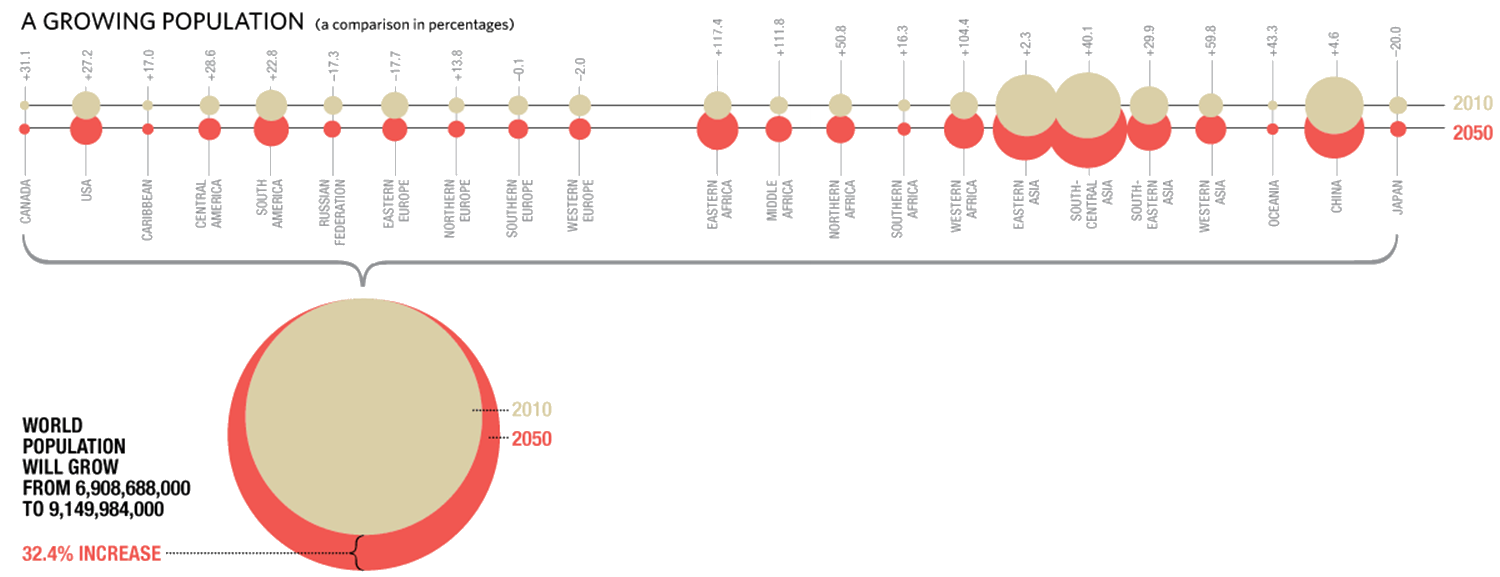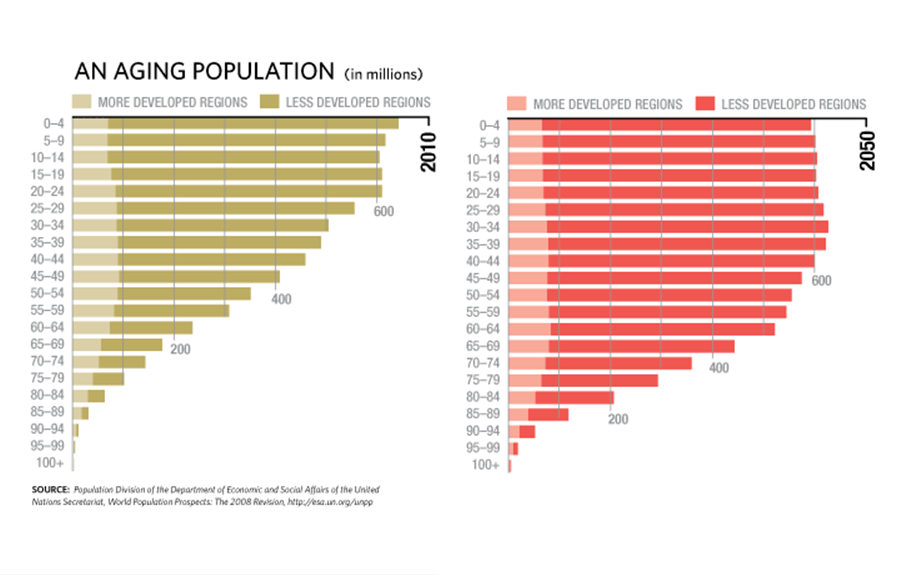Demographics and economics have always had a connection. For years, uncontrolled growth in the developing world was pointed to as one of the reasons that people there were mired in poverty. That belief led China to adopt a one-child policy and pushed many non-governmental organizations to support family planning efforts. As a side note, China’s one-child policy led to couples favoring having boys over girls. As a result, it has become difficult in some parts of the country for men to find a wife. But times are changing and a recent report indicates that more and more couples in China now prefer to have girls [“China bubble erodes preference for sons,” by Patti Waldmeir, Financial Times, 1 November 2010].
We now seem to have a much better picture of where global demographics are heading. Most analysts see the population continuing to increase until around the year 2050. Sometime around the middle of the century, analysts predict that the world will start to depopulate or stabilize. How much will the population grow? Most predictions have the global population rising over the next 40 years by about a third. Scientific American Pathways published a nice graphic showing where this growth is expected to take place.

To learn more about population projections, visit the United Nations site. Having watched China’s spectacular growth, neighboring India is trying to reduce its birthrate by offering couples cash bonuses for not having children [“India Tries Using Cash Bonuses to Slow Birthrates,” by Jim Yardley, New York Times, 21 August 2010]. Yardley reports:
“Sunita Laxman Jadhav is a door-to-door saleswoman who sells waiting. She sweeps along muddy village lanes in her nurse’s white sari, calling on newly married couples with an unblushing proposition: Wait two years before getting pregnant, and the government will thank you. It also will pay you. ‘I want to tell you about our honeymoon package,’ began Ms. Jadhav, an auxiliary nurse, during a recent house call on a new bride … in the state of Maharashtra. Ms. Jadhav explained that the district government would pay 5,000 rupees, or about $106, if the couple waited to have children. Waiting, she promised, would allow them time to finish their schooling or to save money. Waiting also would allow India more time to curb a rapidly growing population that threatens to turn its demography from a prized asset into a crippling burden. With almost 1.2 billion people, India is disproportionately young; roughly half the population is younger than 25.”
Yardley rightfully notes that controlling India’s population is a balancing act. A young and growing population can be a good thing (analysts are increasingly calling it a “demographic dividend). Yardley explains:
“This ‘demographic dividend’ is one reason some economists predict that India could surpass China in economic growth rates within five years. India will have a young, vast work force while a rapidly aging China will face the burden of supporting an older population.”
Aging populations are beginning to burden most of the developed world. In another graphic, Scientific American Pathways shows how the world is aging.

The challenge, of course, is for a decreasing work force to support an increasing population of retired people who generally drain national resources than increase them. That’s why India is not interested in stopping population growth. They just want to slow it down a bit. Yardley continues:
“But if youth is India’s advantage, the sheer size of its population poses looming pressures on resources and presents an enormous challenge for an already inefficient government to expand schooling and other services. In coming decades, India is projected to surpass China as the world’s most populous nation, and the critical uncertainty is just how populous it will be. Estimates range from 1.5 billion to 1.9 billion people, and Indian leaders recognize that that must be avoided. Yet unlike authoritarian China, where the governing Communist Party long ago instituted the world’s strictest population policy, India is an unruly democracy where the central government has set population targets but where state governments carry out separate efforts to limit the birthrate. While some states have reacted to population fears with coercion, forbidding parents with more than two children from holding local office, or disqualifying government workers from certain benefits if they have larger families, other states have done little.”
Many studies have concluded that the best way to control birthrates is to educate females. Educated women generally delay having families and when they do start having children they have fewer of them. Yardley continues:
“Experts say far too many rural women wed as teenagers, usually in arranged marriages, and then have babies in quick succession — a pattern that exacerbates poverty and spurs what demographers call ‘population momentum’ by bunching children together. … India averages about 2.6 children per family, far below what it was a half century ago, yet still above the rate of 2.1 that would stabilize the population. Many states with higher income and education levels are already near or below an average of two children per family. Yet the poorest and most populous states, notably Uttar Pradesh and Bihar, average almost four children per family and have some of the lowest levels of female literacy. ‘An educated girl is your best contraception,’ said Dr. Amarjit Singh, executive director of the National Population Stabilization Fund, a quasi-governmental advisory agency. He said that roughly half of India’s future excess population growth was expected to come from its six poorest states.”
Wall Street Journal columnist David Wessel insists, “Demography is not destiny.” [“The Demographics Driving Nations’ Wealth,” 12 August 2010]. Nevertheless, he insists, demographics still matter. He continues:
“In 1300, China was bigger than Europe and had the world’s most sophisticated technology. But China blew it. By 1850, its population was 65% larger than Europe’s, but—thanks to the Industrial Revolution—Europeans were far richer. Yet demography does matter. ‘We never pay enough attention to demography because it’s so long term,’ says Dominique Strauss-Kahn, head of the International Monetary Fund. So turn for a moment from angst about the disappointing pace of the economic recovery and daunting government budget deficits, and look over the horizon. Over the next 40 years, Japan and Europe will see working-age populations shrink by 30 million and 37 million, respectively, according to United Nations projections. Birth rates are low and so many of their people are already elderly. China’s working-age population will keep growing for 15 years or so, then turn down, the result of its one-child policy and the tendency of birth rates to fall as incomes rise. In 2050, the U.N. projects, China will have 100 million fewer workers than it does today. India’s population, in contrast, will grow by 300 million working-age persons over the next 40 years. The U.S. is in between, benefiting from a higher birth rate and younger populations than Europe and Japan and more immigration. It is projected to add 35 million working-age persons by 2050.”
Wessel then asks the million dollar question, “So what?” He answers that rhetorical question this way:
“History, as interpreted by modern economists pondering the mysteries of growth, teaches that more people lead to more ideas. And unlike land or oil, ideas can be used by more than one person simultaneously. Before countries began sharing ideas, the biggest had the most rapid technological progress. Now, trade, travel and the Internet speed new ideas around the globe ever-more rapidly. So the benefits are dispersed. Belgium is rich not because it is big or has invented a lot, but because it has the wherewithal to employ technology invented by others, notes Michael Kremer of Harvard University. Zaire is bigger, but lacks the wherewithal. ‘In the coming decades, because of the Internet, because of many other changes that have shrunk the world, it’s almost impossible for an individual country to keep proprietary technology for itself,’ says Mr. Strauss-Kahn. For a time, relatively small countries like Britain and France were global heavyweights because of their technological prowess. That day is over, he predicts. ‘Power equals numbers,’ he reasons, and that leads him to anticipate the rising influence of China and India.”
Certainly population is one reason that Brazil, India, China, and Indonesia are three of the so-called BRICI countries. The fourth country — Russia — is undergoing a demographic crisis (it has been depopulating) and some analysts no longer consider it in the same category as the other four. While the BICI’s economies are growing robustly, Russia’s economy is stagnant and remains too dependent on the price of and demand for oil and gas. Wessel notes that “rising populations—and growing numbers of meat-eating, oil-burning consumers—create tension between environmental costs and idea-generating benefits.” The Economist can be counted among organizations that see the idea-generating benefits of growing populations [“The other demographic dividend,” 7 October 2010]. The magazine believes that “emerging markets are teeming with young entrepreneurs. As a result, it claims that emerging market countries are undergoing a business revolution. It reports:
“Emerging-world businesses have traditionally been obsessed with seniority. Ambitious youngsters in countries like India have been equally obsessed with job security. Well-paying jobs, preferably with multinational firms, are the key to success in the marriage market. But this is changing rapidly. Nandan Nilekani, one of the founders of Infosys, reports that he now comes across mould-breaking young leaders wherever he goes in India. They are even to be found in big companies such as ICICI, a leading bank, Hindustan Unilever, a consumer-goods giant, and Comat Technologies, which provides information to rural Indians. Vivek Wadhwa, an American academic who studies entrepreneurship, says he is inundated with requests for meetings whenever he visits the emerging world. He met 125 fledgling entrepreneurs during a recent trip to New Delhi and will talk to as many as he can manage in Beijing soon. The rise of young entrepreneurs is extending the meaning of the demographic dividend. Demographers have often noted that most of the emerging world will stay young while the rich world ages. In 2020 the median age in India will be 28, compared with 38 in America, 45 in western Europe and 49 in Japan. But the dividend will be paid not just in the form of more favourable dependency ratios but also in a more entrepreneurial business culture. Young people are innately more inclined to overthrow the existing order than are their elders.”
The Economist claims that the predisposition of the young to overthrow existing orders is being reinforced by two other revolutions — the revolution in IT and a revolution in entrepreneurship. Concerning the IT revolution, the magazine reports:
“The Boston Consulting Group calculates that there are already about 610m internet users in the BRICI countries (Brazil, Russia, India, China and Indonesia). BCG predicts that this number will nearly double by 2015. And in one respect many consumers in emerging markets are leapfrogging over their Western peers. They are much more likely to access the internet via mobile devices (which are ubiquitous in the emerging world) rather than PCs. That gives local entrepreneurs an advantage, says Rob Salkowitz, the author of ‘Young World Rising’. Whereas Western companies are hampered by legacy systems and legacy mindsets, they can build their companies around the coming technology.”
For years people assumed that the developing world didn’t care much about technology. When mobile devices were introduced in developing areas, however, the world learned that people living there were hungry to connect with others. Concerning the pro-entrepreneurial revolution, the magazine writes:
“Global institutions such as the World Bank and the World Economic Forum have helped to popularise entrepreneurialism. … Several big companies have also encouraged the trend. Microsoft is helping local businesses and NGOs improve information-technology infrastructure. Goldman Sachs is spending $100m on female entrepreneurs, many of them in emerging markets. But even more important than these external nudges are internal changes. The rise of a cohort of highly successful local start-ups such as India’s Infosys, Argentina’s Globant and Ghana’s SOFTtribe has had a dramatic effect on thinking across the region. These companies have demonstrated that young entrepreneurs can succeed mightily: the seven founders of Infosys were in their 20s when they set the company up. They have also created a group of middle-class people who have the wherewithal to bankroll risk: parents who have made money in Infosys or young people who decide to set up on their own after a few fat years in the corporate world.”
According to the article, young entrepreneurs still face severe obstacles in parts of the world.
“In Nigeria the fashion for cyber-crime has all but killed legitimate cyber-business: PayPal will not accept payments from people with a Nigerian internet address. In Latin America many young entrepreneurs operate in an informal economy where innovation is rare and capital hard to come by. Yet entrepreneurial energies are moving eastward. The fact that many rich-world companies have responded to the economic slump by stopping hiring younger workers will only accelerate the shift. One of the most popular [recent] films in America … is ‘The Social Network’, about a group of young Harvard students who founded one of the world’s fastest-growing companies, Facebook. The next Facebook is increasingly likely to be founded in India or Indonesia rather than middle-aged America or doddery old Europe.”
Returning to David Wessel’s article, he concludes:
“Divergences in demographics have national consequences. Today, one in five Japanese and Europeans is over age 65. In 2050, it will be one in three. Rapid productivity growth—the amount of stuff produced per hour of work—could make it easier for working-age populations to support the old folks, but productivity trends aren’t promising. The Japanese and Europeans almost surely will have to work longer, take fewer vacations and probably pay more taxes. Aging also threatens the Japanese government’s ability to keep borrowing so heavily. IMF economist Kiichi Tokuoka estimates that at least half of Japanese government borrowing is now financed, directly or indirectly, by Japanese households; unlike the U.S., Japan doesn’t borrow heavily from abroad. Japanese savers will be selling bonds in retirement—and there aren’t enough younger workers to save enough to pick up the slack. For China, the challenge is to build social structures and retirement schemes to sustain a growing cadre of old folks that, unlike previous generations, won’t be able to rely so much on its children for support. Today, 1.4% of Chinese are over age 80; in 2050, 7.2% will be, the U.N. projects. India has more time to adjust since its working population is likely to keep growing. Its challenge is to harness the growing number of workers in their 30s and 40s and to nurture industry and services. If India dismantles archaic labor laws, brings more women into the work force and invests in training and education, demographics could add four percentage points a year to economic growth, Goldman Sachs economists estimate. But that’s a big ‘if.’ And the U.S.? For all today’s gloom, it may be in the sweet spot. A growing population, an openness to ambitious immigrants and trade (if not disrupted by xenophobic politics) and strong productivity growth (if sustained) could lift living standards and bring faster growth, which would reduce big government budget deficits far easier for the U.S. than for slower growing Europe and Japan.”
Demographics might not be destiny, but they certainly play a large role in economic outcomes. A young, healthy, and educated population will be important for many emerging market countries in the future. Enlightened immigration policies are also going to be important because not all of those bright young people are going to be able to find work in their native lands. British entrepreneur Luke Johnson believes that Britain as well as other developed countries need to reform their immigration policies and adopt a more international view [“Put out the welcome sign for immigrants,” Financial Times, 2 November 2010].
“Globalisation means we need a more international outlook than ever. Just as protectionism over trade leads to impoverishment, so parochialism over immigration is likely to lead to a lower standard of living. Immigrants tend not to be the welfare dependants that extremists would have us believe; rather, my experience is that they are the go-ahead types who take risks and have initiative. Australia, Germany, Canada and the US all have a higher proportion of their population born overseas than is the case in the UK – and all have a higher gross domestic product per capita than we do. The challenge is not immigration: the challenge is to reform our society in order to educate and convince more natives to take control of their destinies, rather than blame others for their shortcomings.”
Despite the economic realities associated with demographics, immigration and the so-called global commute are going to remain sensitive subjects for decades to come. Perhaps countries will begin taking a more serious international outlook when the global population stabilizes or begins to decline.




